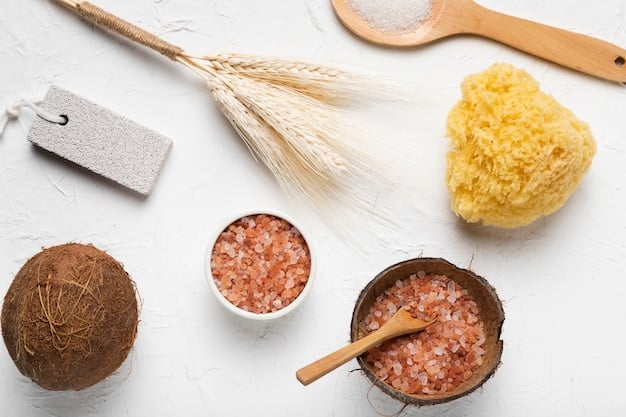The Truth About Exfoliation: Choosing the Right Exfoliant for Your Skin

The Truth About Exfoliation: How to Choose the Right Exfoliant for Your Skin Type involves understanding your skin’s unique needs and selecting a product–physical or chemical–that gently removes dead cells, revealing a brighter complexion without causing irritation or damage.
Unlocking radiant skin doesn’t always require complex treatments; often, the answer lies in simple yet effective techniques like exfoliation. But with a plethora of products on the market, understanding the truth about exfoliation: how to choose the right exfoliant for your skin type is crucial to achieving a healthy glow, without compromising your skin barrier.
The Fundamentals of Exfoliation
Exfoliation, at its core, is the process of removing dead skin cells from the surface of your skin. This process can reveal a smoother, brighter complexion and allow skincare products to penetrate more effectively. Although seemingly simple, understanding the nuances of exfoliation is key to achieving the best results for your unique skin type.
Why is exfoliation so important? As we age, the natural cell turnover process slows down, leading to a buildup of dead cells. This buildup can result in dullness, clogged pores, and even breakouts. Regular exfoliation helps to prevent these issues, promoting healthier and more vibrant skin. However, it’s essential to approach exfoliation with care, as over-exfoliating can lead to irritation and damage.
The Benefits of Regular Exfoliation
Proper exfoliation can provide a multitude of benefits for your skin. From improving texture to reducing the appearance of fine lines, here’s what you can expect:
- Smoother Skin: Exfoliation removes rough, dead skin cells, revealing a smoother surface.
- Brighter Complexion: By removing the dull top layer, your skin appears more radiant and glowing.
- Improved Product Absorption: Exfoliated skin allows serums and moisturizers to penetrate more effectively.
- Reduced Breakouts: Removing dead skin cells helps to unclog pores, preventing acne.
In summary, exfoliation is a cornerstone of a healthy skincare routine, providing multiple benefits when done correctly. By understanding its fundamental principles, you can pave the way for a more youthful and radiant complexion.
Physical vs. Chemical Exfoliation
When it comes to exfoliation, there are primarily two categories: physical and chemical. Each method works differently and offers unique advantages and disadvantages. Understanding the distinction between these two types is crucial for selecting the best option for your skin type and concerns.
Physical exfoliants involve manual scrubbing to remove dead skin cells. On the other hand, chemical exfoliants use acids or enzymes to dissolve the bonds holding the dead cells together. Both can be effective when used correctly, but they are not interchangeable, and choosing the wrong one can lead to adverse reactions.
Understanding Physical Exfoliants
Physical exfoliants work by physically sloughing off dead skin cells. Examples include:
- Scrubs: These contain small particles like sugar, salt, or beads to manually scrub the skin.
- Brushes: Exfoliating brushes, either manual or electric, can provide a deeper level of exfoliation.
- Sponges: Textured sponges, such as konjac sponges, gently exfoliate while cleansing.

Understanding Chemical Exfoliants
Chemical exfoliants utilize acids or enzymes to dissolve the bonds between dead skin cells. The most common types include:
- AHAs (Alpha Hydroxy Acids): Glycolic and lactic acids are AHAs that exfoliate the skin’s surface, improving texture and tone.
- BHAs (Beta Hydroxy Acids): Salicylic acid is a BHA that penetrates deeper into pores to dissolve oil and debris, making it ideal for acne-prone skin.
- Enzymes: Enzymes, often derived from fruits like papaya or pineapple, offer a gentle form of chemical exfoliation.
To conclude, both physical and chemical exfoliation methods have their place in a well-rounded skincare routine. The key is to select the one that best suits your skin type and address your specific skincare concerns, ensuring that you achieve exfoliation benefits without causing damage.
Exfoliation and Different Skin Types
Your skin type plays a pivotal role in determining the right exfoliation method and product. Each skin type – whether dry, oily, sensitive, or combination – has unique characteristics and reacts differently to various exfoliants. Understanding these nuances is essential to avoid irritation and maximize the benefits of exfoliation.
Choosing the correct exfoliant can address specific concerns associated with each skin type, such as dryness, excess oil, or sensitivity. Let’s delve into each skin type and explore the most suitable exfoliation methods and products.
Exfoliating Dry Skin
Dry skin often lacks moisture and can be prone to flakiness and dullness. When exfoliating dry skin, it’s essential to use gentle methods and hydrating products to avoid further dryness:
- Choose a gentle physical exfoliant, such as a konjac sponge.
- Opt for a chemical exfoliant with lactic acid, which is hydrating.
- Always follow up with a rich moisturizer to replenish moisture.
Exfoliating Oily Skin
Oily skin tends to produce excess sebum, leading to clogged pores and breakouts. To effectively exfoliate oily skin:
- Use a BHA (salicylic acid) to penetrate pores and dissolve oil.
- Consider a slightly more abrasive physical scrub, but use it sparingly.
- Avoid over-exfoliating, as it can stimulate more oil production.
Exfoliating Sensitive Skin
Sensitive skin is easily irritated, so it requires a very gentle approach to exfoliation:
- Opt for enzyme exfoliants, which are gentler than AHAs or BHAs.
- Use a soft washcloth for gentle physical exfoliation.
- Always patch-test new products to ensure they don’t cause irritation.
In conclusion, understanding your skin type and its specific needs is crucial when selecting an exfoliation method and product. By tailoring your exfoliation routine to your skin type, you can safely and effectively achieve a healthier, more radiant complexion.
How to Choose the Right Exfoliant
Selecting the right exfoliant can feel overwhelming, with so many options available. As a result, it’s essential to cut through the marketing noise and consider a few key factors. This ensures you’re choosing a product that not only suits your skin type but also addresses your specific skincare concerns.
The process involves assessing your skin’s needs, understanding the ingredients, and knowing how often to exfoliate. Let’s explore some guidelines to simplify the decision-making process.
Consider Your Skin’s Sensitivity
One of the most important considerations is your skin’s sensitivity. If you have sensitive skin, you should start with very gentle exfoliants and gradually increase intensity if needed:
- Start with enzyme masks or very gentle scrubs.
- Avoid products with harsh chemicals or abrasive particles.
- Always do a patch test before applying any new exfoliant to your entire face.

Read the Ingredient List
Pay close attention to the ingredient list. Understand what each ingredient does and how it might affect your skin:
- Look for ingredients like salicylic acid, glycolic acid, lactic acid, or fruit enzymes.
- Avoid products with artificial fragrances, dyes, or preservatives, which can irritate sensitive skin.
- Choose products with hydrating ingredients like hyaluronic acid or glycerin.
Frequency of Exfoliation
The frequency of exfoliation depends on your skin type and the type of exfoliant you’re using:
- Oily skin can typically handle exfoliation 2-3 times per week.
- Dry or sensitive skin should be exfoliated only once or twice a week.
- Always monitor your skin for signs of irritation and adjust accordingly.
Overall, choosing the right exfoliant involves careful consideration of your skin’s sensitivity, a thorough review of the ingredient list, and a mindful approach to the frequency of exfoliation. By following these guidelines, you can effectively enhance your skincare routine and achieve optimal results.
Common Exfoliation Mistakes to Avoid
While exfoliation can be incredibly beneficial for your skin, it’s easy to make mistakes that can lead to irritation, dryness, and even damage. Recognizing and avoiding these common pitfalls can help you ensure that you’re getting the most out of your exfoliation routine.
Common mistakes include over-exfoliating, using overly harsh products, and neglecting post-exfoliation care. By addressing each of these issues, you can refine your skincare practices and maintain healthy, radiant skin.
Over-Exfoliating
One of the most common mistakes is exfoliating too frequently. Over-exfoliating can strip the skin of its natural oils, leading to:
- Redness and inflammation
- Dryness and flakiness
- Increased sensitivity to other products
Using Harsh Products
Using products that are too abrasive or contain harsh chemicals can also harm your skin:
- Avoid scrubs with large, jagged particles that can cause micro-tears in the skin.
- Steer clear of chemical exfoliants with high concentrations of acids, especially if you have sensitive skin.
- Always patch-test new products to ensure they don’t cause irritation.
Neglecting Post-Exfoliation Care
What you do after exfoliating is just as important as the exfoliation itself. Neglecting proper post-exfoliation care can lead to dryness and irritation:
- Always follow up with a hydrating serum and moisturizer
- Apply sunscreen to protect your newly exfoliated skin from UV damage.
- Avoid using other harsh actives, like retinol, immediately after exfoliating.
In summary, avoiding common exfoliation mistakes like over-exfoliating, using harsh products, and neglecting post-exfoliation care can help you maintain healthy, radiant skin. By refining your exfoliation technique, you can maximize the benefits and minimize the risks associated with this crucial skincare practice.
Integrating Exfoliation Into Your Routine
Incorporating exfoliation into your skincare routine should be done strategically. Not every day needs to involve exfoliation, and it’s important to know when and how to include it within your established routine.
When integrating this practice, consider the timing, other products you’re using, and how your skin responds. This enables you to take a balanced approach that enhances your skin’s health without causing adverse effects.
Timing Is Everything
The timing of your exfoliation routine can make a significant difference in its effectiveness:
- Exfoliate in the evening to allow your skin to recover overnight.
- Avoid exfoliating in the morning if you plan to spend a lot of time outdoors, as newly exfoliated skin is more susceptible to sun damage.
- Consider exfoliating before applying a hydrating mask or serum to enhance product absorption.
Consider Other Products
Be mindful of the other products you’re using in your skincare routine:
- Avoid using other harsh actives, like retinol or vitamin C, on the same day as exfoliation.
- Pair exfoliation with hydrating and soothing products to maintain moisture and prevent irritation.
- Adjust your routine based on how your skin responds to the combination of products.
Listen to Your Skin
Ultimately, the best way to integrate exfoliation is to listen to your skin:
- Pay attention to any signs of irritation, dryness, or sensitivity.
- Adjust the frequency and intensity of exfoliation based on your skin’s needs.
- Be patient and consistent – it may take time to find the right balance.
In conclusion, integrating exfoliation effectively into your skincare routine involves strategic timing, careful consideration of other products, and attentive listening to your skin. By adopting a balanced and mindful approach, you can optimize the benefits of exfoliation and attain a healthier, more radiant complexion.
| Key Point | Brief Description |
|---|---|
| ✨ Types of Exfoliation | Physical exfoliants scrub; chemical exfoliants use acids/enzymes. |
| 💧 Exfoliating Dry Skin | Choose gentle exfoliants and hydrate well afterwards. |
| 🧴 Harsh Products | Avoid those with jagged particles/high acid concentrations. |
| 🗓️ Timing Your Exfoliation | Exfoliate in the evening to let skin recover overnight. |
Frequently Asked Questions
▼
Exfoliation removes dead skin cells from the surface, revealing brighter, smoother skin. It also improves product absorption & prevents clogged pores, making it look healthier and more vibrant overall.
▼
It depends on your skin type. Physical exfoliation is good for oily skin, while chemical exfoliation is often better for sensitive or dry mature skin. Both gently remove dead skin with benefits.
▼
Typically, you should exfoliate 1-3 times per week, depending on your skin type and the exfoliant used. Over-exfoliating can cause irritation, dryness, and sensitivity, so adjust based on your skin’s reaction.
▼
Exfoliating can help with acne by unclogging pores and removing dead skin cells that contribute to breakouts. Chemical exfoliants, like salicylic acid, is often advised.
▼
Yes, over-exfoliating can lead to redness, irritation, dryness, and increased sensitivity. It’s essential to exfoliate in moderation and adjust your routine based on how your skin feels and looks.
Conclusion
Understanding the truth about exfoliation: how to choose the right exfoliant for your skin type is crucial for achieving a healthy and radiant complexion. By considering your skin type, selecting appropriate products, avoiding common mistakes, and integrating exfoliation strategically into your routine, you can unlock the many benefits this skincare practice offers, ensuring your skin remains healthy, balanced, and beautifully radiant.





